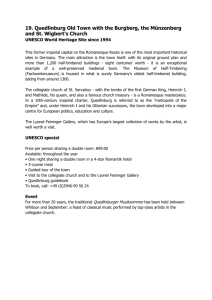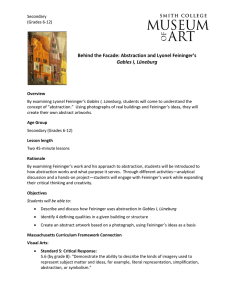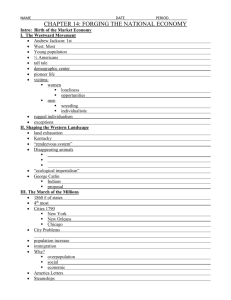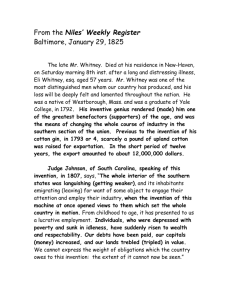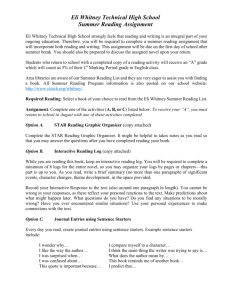THE WHITNEY TO PRESENT LYONEL FEININGER: AT THE EDGE
advertisement
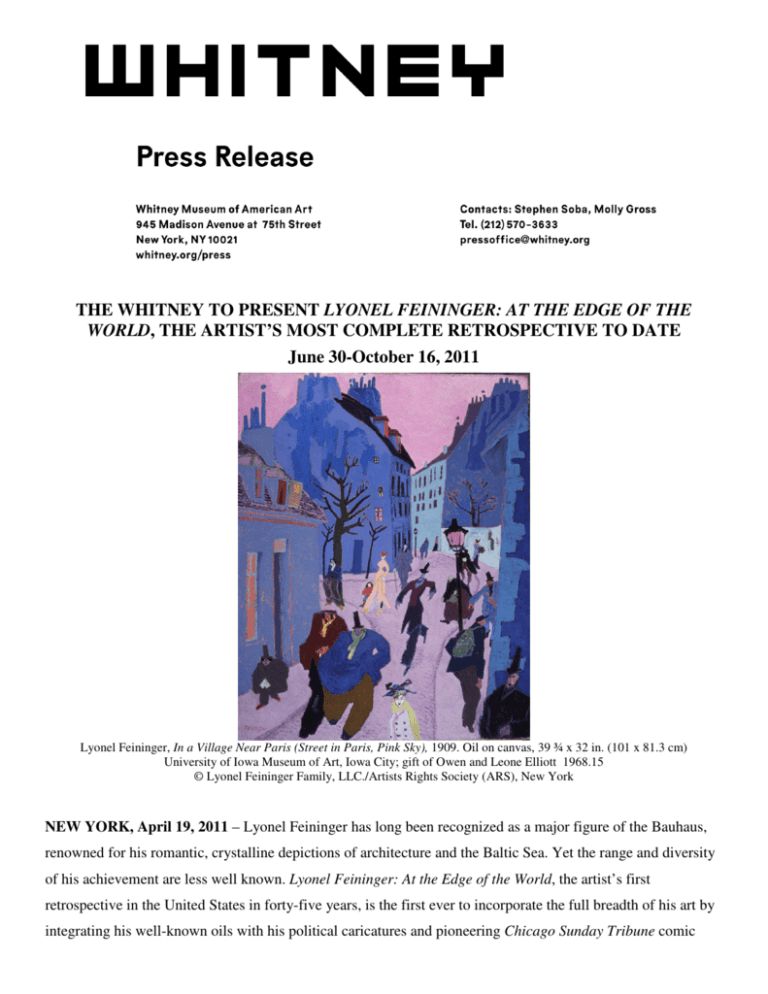
THE WHITNEY TO PRESENT LYONEL FEININGER: AT THE EDGE OF THE WORLD, THE ARTIST’S MOST COMPLETE RETROSPECTIVE TO DATE June 30-October 16, 2011 Lyonel Feininger, In a Village Near Paris (Street in Paris, Pink Sky), 1909. Oil on canvas, 39 ¾ x 32 in. (101 x 81.3 cm) University of Iowa Museum of Art, Iowa City; gift of Owen and Leone Elliott 1968.15 © Lyonel Feininger Family, LLC./Artists Rights Society (ARS), New York NEW YORK, April 19, 2011 – Lyonel Feininger has long been recognized as a major figure of the Bauhaus, renowned for his romantic, crystalline depictions of architecture and the Baltic Sea. Yet the range and diversity of his achievement are less well known. Lyonel Feininger: At the Edge of the World, the artist’s first retrospective in the United States in forty-five years, is the first ever to incorporate the full breadth of his art by integrating his well-known oils with his political caricatures and pioneering Chicago Sunday Tribune comic strips; his figurative German Expressionist compositions; his architectural photographs of Bauhaus and New York subjects; his miniature hand-carved, painted wooden figures and buildings, known as City at the Edge of the World; and his ethereal late paintings of New York City. Curated by Barbara Haskell with the assistance of Sasha Nicholas, the exhibition debuts at the Whitney Museum of American Art from June 30 to October 16, 2011, and subsequently travels to The Montreal Museum of Fine Arts, January 16 –May 13, 2012. Born and raised in New York City, Lyonel Feininger (1871–1956) moved at the age of sixteen to Germany to study music. Instead, he became a caricaturist and eventually a leading member of the German Expressionist groups Die Brücke and Die Blaue Reiter and, later, the Bauhaus. In the late 1930s, when the Nazi campaign against modern art necessitated his return to New York after an absence of fifty years, his marriage of abstraction and recognizable imagery made him a beloved artist in the United States. Having spent fifty years of his life in Germany, Feininger is most often considered a German artist. This exhibition and its accompanying catalogue illuminate his dual national loyalties and their reverberations in his art. As Haskell notes in her catalogue essay: “(Feininger’s) complex and contradictory allegiances—to American ingenuity and lack of pretension on the one hand, and to German respect for tradition and learning on the other—rendered him an outsider in both countries. Always yearning for one world while living in the other, he never stopped longing for the ‘lost happiness’ of his childhood.” Before he began to paint in 1907, at the age of thirty-six, Feininger had built a career as one of Germany's most successful caricaturists. When he turned to painting, he fused the whimsical figuration of his comic strips and illustrations with the high-keyed color of German Expressionist painting. Just at the moment that Feininger's oils began to earn him widespread recognition, World War I broke out. He spent the war in Germany as an enemy alien, never having relinquished his American citizenship. In 1919, Walter Gropius, founder of the Bauhaus, appointed Feininger as the school's first professor and commissioned him to design the cover of the Bauhaus manifesto. Feininger's expressionist woodcut, depicting a tripartite cathedral surrounded by shooting stars, symbolized the school's idealistic unification of fine art, architecture, and crafts. Feininger remained at the Bauhaus until it was closed by the Nazis in 1933, revered as a teacher and head of the school's graphics workshop. The monumental compositions of architectural and seascape subjects that he produced at the Bauhaus gained him national renown, culminating in his receipt in 1931 of Germany's highest honor for an artist: a large-scale retrospective at Berlin's National Gallery. When the Nazi Party came to power in 1933, the situation became unbearable for Feininger and his wife, who was Jewish. They moved to America in 1937, just months before his work was featured in the Nazi's infamous Degenerate Art exhibition. Readjusting to the changed landscape of New York was difficult after such a long absence; not until 1939 did Feininger begin painting again. In America, as in Germany, he employed geometric forms to invest the modern world with a secular spirituality. Art, for him, was a "path to the intangibly Divine,” a way of expressing what he called the “glory there is in Creation." At the same time, Feininger continued in his last years to call upon the playful figurative vocabulary of his early illustrations and comics to evoke the harmony and innocence of childhood. Feininger's 1944 retrospective at the Museum of Modern Art, which traveled for two years to major American cities, established him as a major artist in his native country during his final years. Panel on Feininger and Comics Lyonel Feininger is considered one of the pioneers of modern comic art. His short-lived Chicago Tribune comic strips, The Kin-der-Kids and Wee Willie Winkie’s World, “achieved a breathtaking formal grace unsurpassed in the history of the medium,” as Art Spiegelman noted. A panel discussion, “Comics Stars and Strips,” will take place on Wednesday, July 20, at 7 pm, in the Whitney’s lower gallery. Inspired by the exhibition Lyonel Feininger: At the Edge of the World, the panel of master comic artists, including Art Spiegelman, Chris Ware, and Gary Panter, will discuss the intersection of comics and fine art. Moderated by John Carlin. Further information will be available at whitney.org. Concert to Include Feininger’s Music Feininger began his career as a violinist. Even after he shifted to fine art, he continued to regard music as the language of his “innermost self.” Between 1921 and 1927, he created twelve fugues, primarily for organ, in the style of Johannes Sebastian Bach. Only a few of them were ever performed publically. The American Symphony Orchestra will premiere three of Feininger’s fugues, along with Bach orchestrations by composers such as Arnold Schoenberg and Max Reger. The concert will explore the inspiration Bach exerted on German modernism in the first half of the twentieth-century. “Bauhaus Bach” American Symphony Orchestra Friday, October 21, 2011, at 8pm Carnegie Hall The program: Bach/Max Reger, Aria “O Mensch, bewein dein Sünde groß” BWV 622 Bach/Arnold Schoenberg, Chorale Prelude “Komm, Gott, Schöpfer, Heiliger Geist” BWV 631 Feininger/, Three Fugues, orchestrated by Richard Wilson Schoenberg, Variations for Orchestra, Op. 31 Bach/Schoenberg, Prelude and Fugue, BWV 552, “St. Anne” Bach/Wolfgang Gräser, Selections from The Art of the Fugue For ticket information, please visit www.americansymphony.org. The Book A monograph accompanying the exhibition, with its overview essay by Whitney curator Barbara Haskell, covers the full breadth of Feininger’s career, placing his biography and art within the context of art history and politics, tracing his relationships to movements and institutions that defined the development of modern art, including Cubism, the Blaue Reiter, the Blue Four, the Bauhaus, and Black Mountain College. The catalogue features additional essays by Ulrich Luckhardt, curator, Hamburger Kunsthalle, Germany; Sasha Nicholas, senior curatorial assistant, Whitney Museum of American Art, New York; Bryan Gilliam, Frances Hill Fox Professor in Humanities, Duke University; John Carlin, independent writer and curator, president and CEO of Funny Garbage. The book is published by the Whitney Museum of American Art, New York, in association with Yale University Press, New Haven and London. Sponsorship Credits Lyonel Feininger: At the Edge of the World was organized by the Whitney Museum of American Art, New York, in collaboration with the Montreal Museum of Fine Arts. This exhibition and catalogue are made possible, in part, by generous grants from the Terra Foundation for American Art and the Henry Luce Foundation. Major underwriting for this exhibition is provided by the Anna-Maria and Stephen Kellen Foundation, in memory of Stephen M. Kellen. Additional support is provided by The Shen Family Foundation, the Karen and Kevin Kennedy Foundation, Susan R. Malloy, Déborah, André and Dan Mayer, Carol and Paul Miller, Joseph Edelman and Pamela Keld, Geraldine S. Kunstadter, the Karen and Paul Levy Family Foundation, Marica and Jan Vilcek, the Consulate General of the Federal Republic of Germany, and several anonymous donors. About the Whitney The Whitney Museum of American Art is the world’s leading museum of twentieth-century and contemporary art of the United States. Focusing particularly on works by living artists, the Whitney is celebrated for presenting important exhibitions and for its renowned collection, which comprises over 18,000 works by more than 2,800 artists. With a history of exhibiting the most promising and influential artists and provoking intense debate, the Whitney Biennial, the Museum's signature exhibition, has become the most important survey of the state of contemporary art in the United States. In addition to its landmark exhibitions, the Museum is known internationally for events and educational programs of exceptional significance and as a center for research, scholarship, and conservation. Founded by sculptor and arts patron Gertrude Vanderbilt Whitney in 1930, the Whitney was first housed on West 8th Street in Greenwich Village. The Museum relocated in 1954 to West 54th Street and, in 1966, inaugurated its present home, designed by Marcel Breuer, at 945 Madison Avenue on the Upper East Side. While its vibrant program of exhibitions and events continues uptown, the Whitney is moving forward with a new building project, designed by Renzo Piano, in downtown Manhattan. Located at the corner of Gansevoort and Washington Streets in the Meatpacking District, at the southern entrance to the High Line, the new building, which has generated immense momentum and support, will enable the Whitney to vastly increase the size and scope of its exhibition and programming space. Ground will be broken on the new building in May 2011, and it is projected to open to the public in 2015. Current and Upcoming Exhibitions at the Whitney Museum of American Art Legacy: The Emily Fisher Landau Collection Glenn Ligon: AMERICA Dianna Molzan: Bologna Meissen More Than That: Films by Kevin Jerome Everson Through May 1, 2011 Through June 5, 2011 Through June 19, 2011 April 28–September 18, 2011 Breaking Ground: The Whitney’s Founding Collection April 28–September 18, 2011 Cory Arcangel: Pro Tools May 26–September 11, 2011 Designing the Whitney of the Future Opens May 26, 2011 Lyonel Feininger: At the Edge of the World June 30–October 23, 2011 Singular Visions Through November 2011 The Whitney Museum is located at 945 Madison Avenue at 75th Street, New York City. Museum hours are: Wednesday, Thursday, Saturday, and Sunday from 11 a.m. to 6 p.m., Friday from 1 p.m. to 9 p.m., closed Monday and Tuesday. General admission: $18. Full-time students and visitors ages 19–25 and 62 & over: $12. Visitors 18 & under and Whitney members: FREE. Admission to the Kaufman Astoria Studios Film & Video Gallery only: $6. Admission is pay-what-you-wish on Fridays, 6–9 p.m. For general information, please call (212) 570-3600 or visit whitney.org. ####
